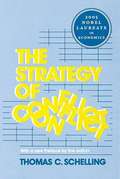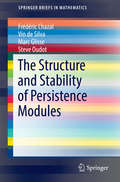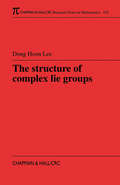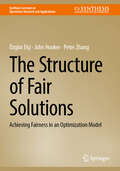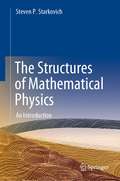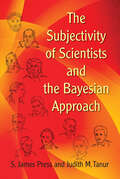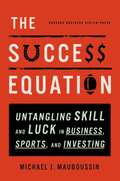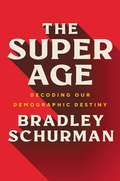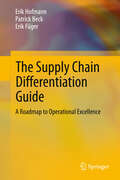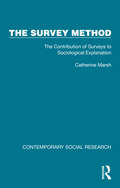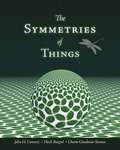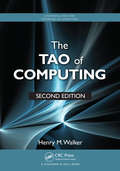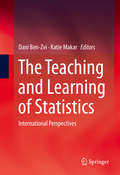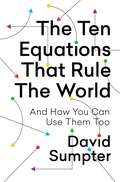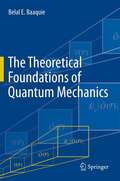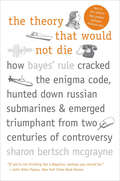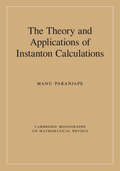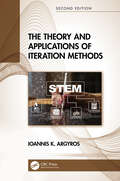- Table View
- List View
The Strategy of Conflict
by Thomas C. SchellingThe text opens to rational analysis a crucial field of politics, the international politics of threat, or as the current term goes, of deterrence.
The Structure and Stability of Persistence Modules
by Frédéric Chazal Vin De Silva Marc Glisse Steve OudotThis book is a comprehensive treatment of the theory of persistence modules over the real line. It presents a set of mathematical tools to analyse the structure and to establish the stability of such modules, providing a sound mathematical framework for the study of persistence diagrams. Completely self-contained, this brief introduces the notion of persistence measure and makes extensive use of a new calculus of quiver representations to facilitate explicit computations. Appealing to both beginners and experts in the subject, The Structure and Stability of Persistence Modules provides a purely algebraic presentation of persistence, and thus complements the existing literature, which focuses mainly on topological and algorithmic aspects.
The Structure of Complex Lie Groups (Chapman & Hall/CRC Research Notes in Mathematics Series)
by Dong Hoon LeeComplex Lie groups have often been used as auxiliaries in the study of real Lie groups in areas such as differential geometry and representation theory. To date, however, no book has fully explored and developed their structural aspects.The Structure of Complex Lie Groups addresses this need. Self-contained, it begins with general concepts
The Structure of Fair Solutions: Achieving Fairness in an Optimization Model (Synthesis Lectures on Operations Research and Applications)
by John Hooker Özgün Elçi Peter ZhangThis book provides a novel and unifying perspective on the structural properties of fair solutions in optimization formulations. The book also addresses a growing interest in incorporating fairness into the models that lie behind many business and public policy decisions. Since there are several ways to formulate fairness mathematically, the authors characterize optimal solutions that result from different formulations with the aim of informing the choice of an appropriate model for a given application. The focus is on fairness criteria that combine efficiency with fairness since typically both are important in practice. Most of these results are new and do not appear in the current literature. The book is directed towards a wide range of audiences including practitioners, researchers in mathematical optimization, and welfare economists. In addition, this book: Presents practical linear, nonlinear, or mixed integer programming formulations and a wide variety of fairness models Includes detailed proofs that provide insight into the properties of each criterion Provides guidelines for selecting a fairness model and the tendency to incentivize cooperation or competition About the Authors Özgün Elçi, Ph.D., is a Research Scientist on the Modeling and Optimization team at Amazon. John Hooker, Ph.D. is University Professor of Operations Research and T. Jerome Holleran Professor of Business Ethics and Social Responsibility, Emeritus, at Carnegie Mellon University. Peter Zhang, Ph.D, is an Assistant Professor at Carnegie Mellon University’s Heinz College of Information Systems and Public Policy.
The Structures of Mathematical Physics: An Introduction
by Steven P. StarkovichThis textbook serves as an introduction to groups, rings, fields, vector and tensor spaces, algebras, topological spaces, differentiable manifolds and Lie groups --- mathematical structures which are foundational to modern theoretical physics. It is aimed primarily at undergraduate students in physics and mathematics with no previous background in these topics. Applications to physics --- such as the metric tensor of special relativity, the symplectic structures associated with Hamilton's equations and the Generalized Stokes's Theorem --- appear at appropriate places in the text. Worked examples, end-of-chapter problems (many with hints and some with answers) and guides to further reading make this an excellent book for self-study. Upon completing this book the reader will be well prepared to delve more deeply into advanced texts and specialized monographs in theoretical physics or mathematics.
The Student's Introduction to Mathematica®
by Bruce F. Torrence Eve A. TorrenceThe unique feature of this compact student's introduction is that it presents concepts in an order that closely follows a standard mathematics curriculum, rather than structure the book along features of the software. As a result, the book provides a brief introduction to those aspects of the Mathematica software program most useful to students. The second edition of this well loved book is completely rewritten for Mathematica 6 including coverage of the new dynamic interface elements, several hundred exercises and a new chapter on programming. This book can be used in a variety of courses, from precalculus to linear algebra. Used as a supplementary text it will aid in bridging the gap between the mathematics in the course and Mathematica. In addition to its course use, this book will serve as an excellent tutorial for those wishing to learn Mathematica and brush up on their mathematics at the same time.
The Subjectivity of Scientists and the Bayesian Approach (Dover Books on Mathematics #775)
by S. James Press Judith M. Tanur"Press and Tanur argue that subjectivity has not only played a significant role in the advancement of science but that science will advance more rapidly if the modern methods of Bayesian statistical analysis replace some of the more classical twentieth-century methods." -- SciTech Book News."An insightful work." - Choice."Compilation of interesting popular problems ... this book is fascinating." -- Short Book Reviews, International Statistical Institute.Subjectivity - including intuition, hunches, and personal beliefs - has played a key role in scientific discovery. This intriguing book illustrates subjective influences on scientific progress with historical accounts and biographical sketches of more than a dozen luminaries, including Aristotle, Galileo, Newton, Darwin, Pasteur, Freud, Einstein, Margaret Mead, and others. The treatment also offers a detailed examination of the modern Bayesian approach to data analysis, with references to the Bayesian theoretical and applied literature. Suitable for lay readers as well as science specialists, this survey will also appeal to historians of science and those interested in knowing more about the Bayesian approach.
The Success Equation
by Michael J. Mauboussin"Much of what we experience in life results from a combination of skill and luck." - From the IntroductionThe trick, of course, is figuring out just how many of our successes (and failures) can be attributed to each-and how we can learn to tell the difference ahead of time.In most domains of life, skill and luck seem hopelessly entangled. Different levels of skill and varying degrees of good and bad luck are the realities that shape our lives-yet few of us are adept at accurately distinguishing between the two. Imagine what we could accomplish if we were able to tease out these two threads, examine them, and use the resulting knowledge to make better decisions. In this provocative book, Michael Mauboussin helps to untangle these intricate strands to offer the structure needed to analyze the relative importance of skill and luck. He offers concrete suggestions for making these insights work to your advantage. Once we understand the extent to which skill and luck contribute to our achievements, we can learn to deal with them in making decisions.The Success Equation helps us move toward this goal by: Establishing a foundation so we better understand skill and luck, and can pinpoint where each is most relevant Helping us develop the analytical tools necessary to understand skill and luck Offering concrete suggestions about how to take these findings and put them to workShowcasing Mauboussin's trademark wit, insight, and analytical genius, The Success Equation is a must-read for anyone seeking to make better decisions-in business and in life.
The Super Age: Decoding Our Demographic Destiny
by Bradley SchurmanA demographic futurist explains the coming Super Age—when there will be more people older than sixty-five than those under the age of eighteen—and explores what it could mean for our collective future. Societies all over the world are getting older, the result of the fact that we are living longer and having fewer children. At some point in the near future, much of the developed world will have at least twenty percent of their national populations over the age of sixty-five. Bradley Schurman calls this the Super Age. Today, Italy, Japan, and Germany have already reached the Super Age, and another ten countries will have gone over the tipping point in 2021. Thirty-five countries will be part of this club by the end of the decade. This seismic shift in the world population can portend a period of tremendous growth—or leave swaths of us behind. Schurman explains how changing demographics will affect government and business and touch all of our lives. Fewer people working and paying income taxes, due to outdated employment and retirement practices, could mean less money feeding popular programs such as Social Security and Medicare—with greater numbers relying on them. The forced retirement or redundancy of older workers could impact business by creating a shortage of workers, which would likely drive wages up and result in inflation. Corporations, too, must rethink marketing strategies—older consumers are already purchasing the majority of new cars, and they are a growing and vitally important market for health technologies and housing. Architects and designers must re-create homes and communities that are more inclusive of people of all ages and abilities.If we aren’t prepared for the changes to come, Schurman warns, we face economic stagnation, increased isolation of at-risk populations, and accelerated decline of rural communities. Instead, we can plan now to harness the benefits of the Super Age: extended and healthier lives, more generational cooperation at work and home, and new markets and products to explore. The choice is ours to make.
The Supply Chain Differentiation Guide: A Roadmap to Operational Excellence
by Erik Hofmann Patrick Beck Erik FügerThe importance of supply chain management has increased over the last few decades. Today, entire supply chains are competing with each other instead of individual companies. As such, supply chain management has become a way for companies to set themselves apart from competing companies and their supply chains. Interestingly, supply chain management mainly focuses on efficiency-oriented topics rather than effectiveness-driven issues, in particular the design of supply chains from manufacturing sites downstream, instead of upstream from the customer. The Supply Chain Differentiation Guide offers a modern approach to supply chain management. While for many years "one-size-fits-all" approaches to supply chain management were very common, the current efforts of managers and academics alike focus on the simultaneous management of multiple supply chains. Despite the interest of the business sector in the management of multiple supply chains, academia has largely neglected this topic to date. The Supply Chain Differentiation Guide addresses this shortcoming, introducing both established and cutting-edge management methods to the context of supply chain differentiation and providing inspirations for how to improve corporate operations.
The Surprise Attack in Mathematical Problems
by Louis A. GrahamFor decades, professionals in applied mathematics and mathematical puzzle fans from all over the world supplied provocative problems to the puzzle columns of the Graham Dial. Upon the appearance of an interesting problem, readers wrote in to the Dial suggesting new approaches to the solution, some greatly simplifying the problem and others broadening its scope. This collection presents 52 of the finest problems, all featuring the "surprise attack" and abounding in imaginative and interesting solutions.The problems involve measurement of geometrical spaces, probabilities, distances, number systems other than the decimal, interesting number relations, relative motion, and the discovery of the simplest solution through purely logical means. Solutions involve such techniques as arithmetic, algebra and geometry, number theory, statistics, networks, and inversion. Several approaches to the solution accompany each problem, and even the best of these represent not the ideal solution but only the most satisfying — so far.
The Surprising Mathematics of Longest Increasing Subsequences
by Dan RomikIn a surprising sequence of developments, the longest increasing subsequence problem, originally mentioned as merely a curious example in a 1961 paper, has proven to have deep connections to many seemingly unrelated branches of mathematics, such as random permutations, random matrices, Young tableaux, and the corner growth model. The detailed and playful study of these connections makes this book suitable as a starting point for a wider exploration of elegant mathematical ideas that are of interest to every mathematician and to many computer scientists, physicists, and statisticians. The specific topics covered are the Vershik-Kerov-Logan-Shepp limit shape theorem, the Baik-Deift-Johansson theorem, the Tracy-Widom distribution, and the corner growth process. This exciting body of work, encompassing important advances in probability and combinatorics over the last 40 years, is made accessible to a general graduate-level audience for the first time in a highly polished presentation.
The Survey Method: The Contribution of Surveys to Sociological Explanation (Contemporary Social Research)
by Catherine MarshIn the early 1980s, the survey was the most widely used method of social research, but it had been the object of much damaging criticism. Critics maintained that there were philosophical flaws inherent in survey practice which made it unacceptable as valid method; sociology students were taught that surveys are ‘positivist’ and that alternatives should be sought wherever possible. In The Survey Method, originally published in 1982, Catherine Marsh examines such claims and shows that much of this criticism was ill-founded.The book shows that surveys do not have to be mere superficial glimpses of the surface features of processes, fact-gathering exercises or opinion polls. Properly designed, executed and analysed, they can actually provide the kind of evidence that social theorists, concerned with uncovering dynamic aspects of social life, will want to use. Catherine Marsh challenges the contention that different research procedures automatically have to commit those who use them either to a particular theory of knowledge, a view of human nature or even a political stance.The Survey Method is neither a pure defence of surveys nor a textbook on how to do them. It does, after all, criticise the kinds of surveys that are often done, and it is particularly hostile to some new and manipulative developments in the often anti-democratic use made of survey results and opinion polls. Catherine Marsh’s aim is to contribute to the methodological debate on survey research. Although the book will find most of its readers among academic sociologists, it also contains a wealth of detail on the history of surveys and an extensive annotated bibliography of the major survey literature. It will accordingly prove essential reading for practising social researchers while re-establishing the credentials of survey research amongst the broader social science community.
The Symbolic Computation of Integrability Structures for Partial Differential Equations (Texts And Monographs In Symbolic Computation Series)
by Joseph Krasil’shchik Alexander Verbovetsky Raffaele VitoloThis is the first book devoted to the task of computing integrability structures by computer. The symbolic computation of integrability operator is a computationally hard problem and the book covers a huge number of situations through tutorials. The mathematical part of the book is a new approach to integrability structures that allows to treat all of them in a unified way. The software is an official package of Reduce. Reduce is free software, so everybody can download it and make experiments using the programs available at our website.
The Symmetries of Things (AK Peters/CRC Recreational Mathematics Series)
by John H. Conway Heidi Burgiel Chaim Goodman-StraussStart with a single shape. Repeat it in some way—translation, reflection over a line, rotation around a point—and you have created symmetry. Symmetry is a fundamental phenomenon in art, science, and nature that has been captured, described, and analyzed using mathematical concepts for a long time. Inspired by the geometric intuition of Bill Thurston and empowered by his own analytical skills, John Conway, with his coauthors, has developed a comprehensive mathematical theory of symmetry that allows the description and classification of symmetries in numerous geometric environments. This richly and compellingly illustrated book addresses the phenomenological, analytical, and mathematical aspects of symmetry on three levels that build on one another and will speak to interested lay people, artists, working mathematicians, and researchers.
The Synoptic Problem and Statistics
by Andris AbakuksSee How to Use Statistics for New Testament InterpretationThe Synoptic Problem and Statistics lays the foundations for a new area of interdisciplinary research that uses statistical techniques to investigate the synoptic problem in New Testament studies, which concerns the relationships between the Gospels of Matthew, Mark, and Luke. There are pote
The Tao of Computing (Chapman & Hall/CRC Textbooks in Computing)
by Henry M. WalkerDescribing both the practical details of interest to students and the high-level concepts and abstractions highlighted by faculty, The Tao of Computing, Second Edition presents a comprehensive introduction to computers and computer technology. This edition updates its popular predecessor with new research exercises and expanded discussion questions
The Teaching and Learning of Statistics
by Katie Makar Dani Ben-ZviThis book presents the breadth and diversity of empirical and practical work done on statistics education around the world. A wide range of methods are used to respond to the research questions that form it's base. Case studies of single students or teachers aimed at understanding reasoning processes, large-scale experimental studies attempting to generalize trends in the teaching and learning of statistics are both employed. Various epistemological stances are described and utilized. The teaching and learning of statistics is presented in multiple contexts in the book. These include designed settings for young children, students in formal schooling, tertiary level students, vocational schools, and teacher professional development. A diversity is evident also in the choices of what to teach (curriculum), when to teach (learning trajectory), how to teach (pedagogy), how to demonstrate evidence of learning (assessment) and what challenges teachers and students face when they solve statistical problems (reasoning and thinking).
The Ten Equations That Rule the World: And How You Can Use Them Too
by David SumpterIs there a secret formula for getting rich? For going viral? For deciding how long to stick with your current job, Netflix series, or even relationship? This book is all about the equations that make our world go round. Ten of them, in fact. They are integral to everything from investment banking to betting companies and social media giants. And they can help you to increase your chance of success, guard against financial loss, live more healthfully, and see through scaremongering. They are known by only the privileged few - until now.With wit and clarity, mathematician David Sumpter shows that it isn't the technical details that make these formulas so successful. It is the way they allow mathematicians to view problems from a different angle - a way of seeing the world that anyone can learn.Empowering and illuminating, The Ten Equations shows how math really can change your life.
The Ten Most Wanted Solutions in Protein Bioinformatics (Chapman & Hall/CRC Computational Biology Series)
by Anna TramontanoUtilizing high speed computational methods to extrapolate to the rest of the protein universe, the knowledge accumulated on a subset of examples, protein bioinformatics seeks to accomplish what was impossible before its invention, namely the assignment of functions or functional hypotheses for all known proteins.The Ten Most Wanted Solutions in Pro
The Theft of a Decade: How the Baby Boomers Stole the Millennials' Economic Future
by Joseph C. SternbergA Wall Street Journal columnist delivers a brilliant narrative of the mugging of the millennial generation-- how the Baby Boomers have stolen the millennials' future in order to ensure themselves a comfortable presentThe Theft of a Decade is a contrarian, revelatory analysis of how one generation pulled the rug out from under another, and the myriad consequences that has set in store for all of us. The millennial generation was the unfortunate victim of several generations of economic theories that made life harder for them than it was for their grandparents. Then came the crash of 2008, and the Boomer generation's reaction to it was brutal: politicians and policy makers made deliberate decisions that favored the interests of the Boomer generation over their heirs, the most egregious being over the use of monetary policy, fiscal policy and regulation. For the first time in recent history, policy makers gave up on investing for the future and instead mortgaged that future to pay for the ugly economic sins of the present. This book describes a new economic crisis, a sinister tectonic shift that is stealing a generation's future.
The Theoretical Foundations of Quantum Mechanics
by Belal E. BaaquieThe Theoretical Foundations of Quantum Mechanics addresses fundamental issues that are not discussed in most books on quantum mechanics. This book focuses on analyzing the underlying principles of quantum mechanics and explaining the conceptual and theoretical underpinning of quantum mechanics. In particular, the concepts of quantum indeterminacy, quantum measurement and quantum superposition are analyzed to clarify the concepts that are implicit in the formulation of quantum mechanics. The Schrodinger equation is never solved in the book. Rather, the discussion on the fundamentals of quantum mechanics is treated in a rigorous manner based on the mathematics of quantum mechanics. The new concept of the interplay of empirical and trans-empirical constructs in quantum mechanics is introduced to clarify the foundations of quantum mechanics and to explain the counter-intuitive construction of nature in quantum mechanics. The Theoretical Foundations of Quantum Mechanics is aimed at the advanced undergraduate and assumes introductory knowledge of quantum mechanics. Its objective is to provide a solid foundation for the reader to reach a deeper understanding of the principles of quantum mechanics.
The Theory That Would Not Die: How Bayes' Rule Cracked the Enigma Code, Hunted Down Russian Submarines, & Emerged Triumphant from Two Centuries of C
by Sharon Bertsch McGrayne"This account of how a once reviled theory, Baye&’s rule, came to underpin modern life is both approachable and engrossing" (Sunday Times). A New York Times Book Review Editors&’ Choice Bayes' rule appears to be a straightforward, one-line theorem: by updating our initial beliefs with objective new information, we get a new and improved belief. To its adherents, it is an elegant statement about learning from experience. To its opponents, it is subjectivity run amok. In the first-ever account of Bayes' rule for general readers, Sharon Bertsch McGrayne explores this controversial theorem and the generations-long human drama surrounding it. McGrayne traces the rule&’s discovery by an 18th century amateur mathematician through its development by French scientist Pierre Simon Laplace. She reveals why respected statisticians rendered it professionally taboo for 150 years—while practitioners relied on it to solve crises involving great uncertainty and scanty information, such as Alan Turing's work breaking Germany's Enigma code during World War II. McGrayne also explains how the advent of computer technology in the 1980s proved to be a game-changer. Today, Bayes' rule is used everywhere from DNA de-coding to Homeland Security. Drawing on primary source material and interviews with statisticians and other scientists, The Theory That Would Not Die is the riveting account of how a seemingly simple theorem ignited one of the greatest controversies of all time.
The Theory and Applications of Instanton Calculations (Cambridge Monographs on Mathematical Physics)
by Manu ParanjapeInstantons, or pseudoparticles, are solutions to the equations of motion in classical field theories on a Euclidean spacetime. Instantons are found everywhere in quantum theories as they have many applications in quantum tunnelling. Diverse physical phenomena may be described through quantum tunnelling, for example: the Josephson effect, the decay of meta-stable nuclear states, band formation in tight binding models of crystalline solids, the structure of the gauge theory vacuum, confinement in 2+1 dimensions, and the decay of superheated or supercooled phases. Drawing inspiration from Sidney Coleman's Erice lectures, this volume provides an accessible, detailed introduction to instanton methods, with many applications, making it a valuable resource for graduate students in many areas of physics, from condensed matter, particle and nuclear physics, to string theory.
The Theory and Applications of Iteration Methods
by Ioannis K. ArgyrosThe theory and applications of Iteration Methods is a very fast-developing field of numerical analysis and computer methods. The second edition is completely updated and continues to present the state-of-the-art contemporary theory of iteration methods with practical applications, exercises, case studies, and examples of where and how they can be used. The Theory and Applications of Iteration Methods, Second Edition includes newly developed iteration methods taking advantage of the most recent technology (computers, robots, machines). It extends the applicability of well-established methods by increasing the convergence domain and offers sharper error tolerance. New proofs and ideas for handling convergence are introduced along with a new variety of story problems picked from diverse disciplines. This new edition is for researchers, practitioners, and students in engineering, economics, and computational sciences.
